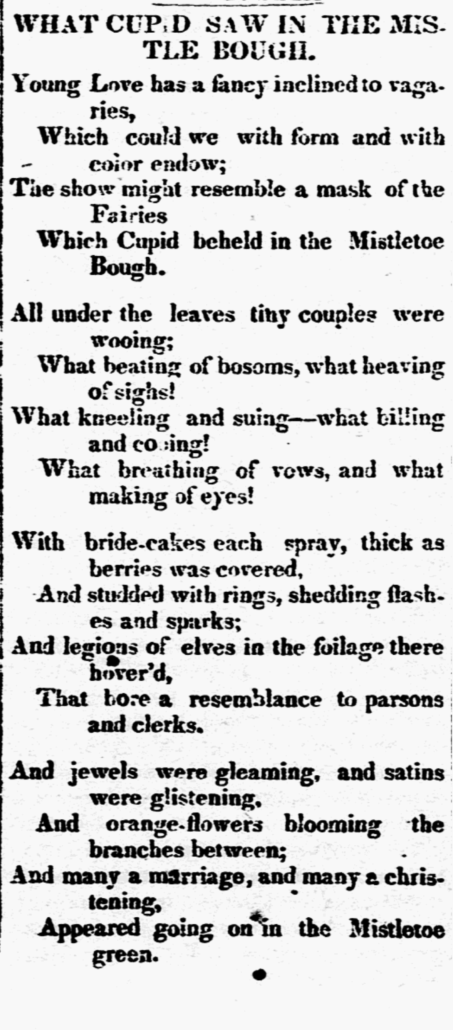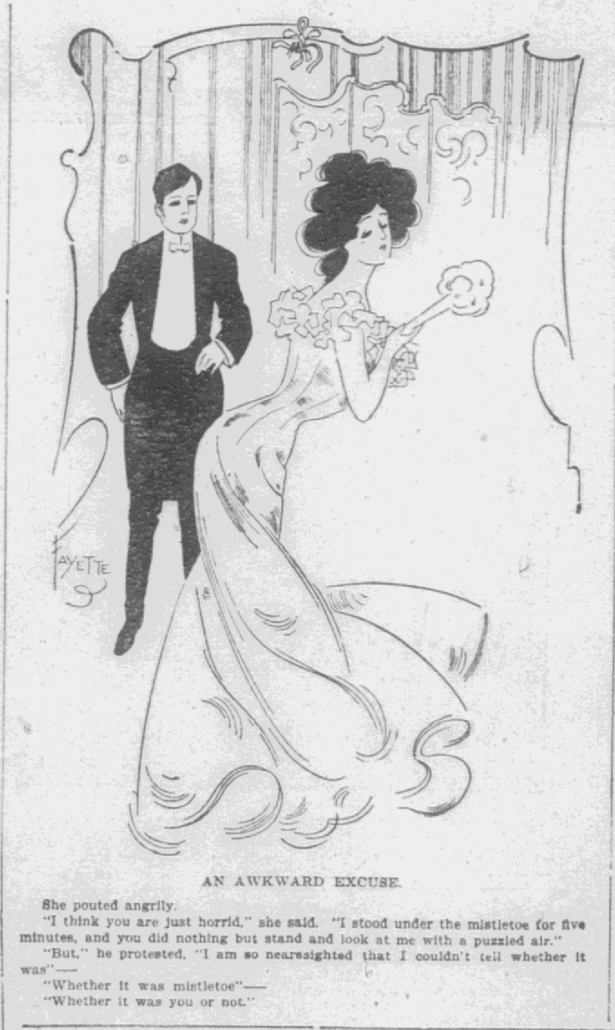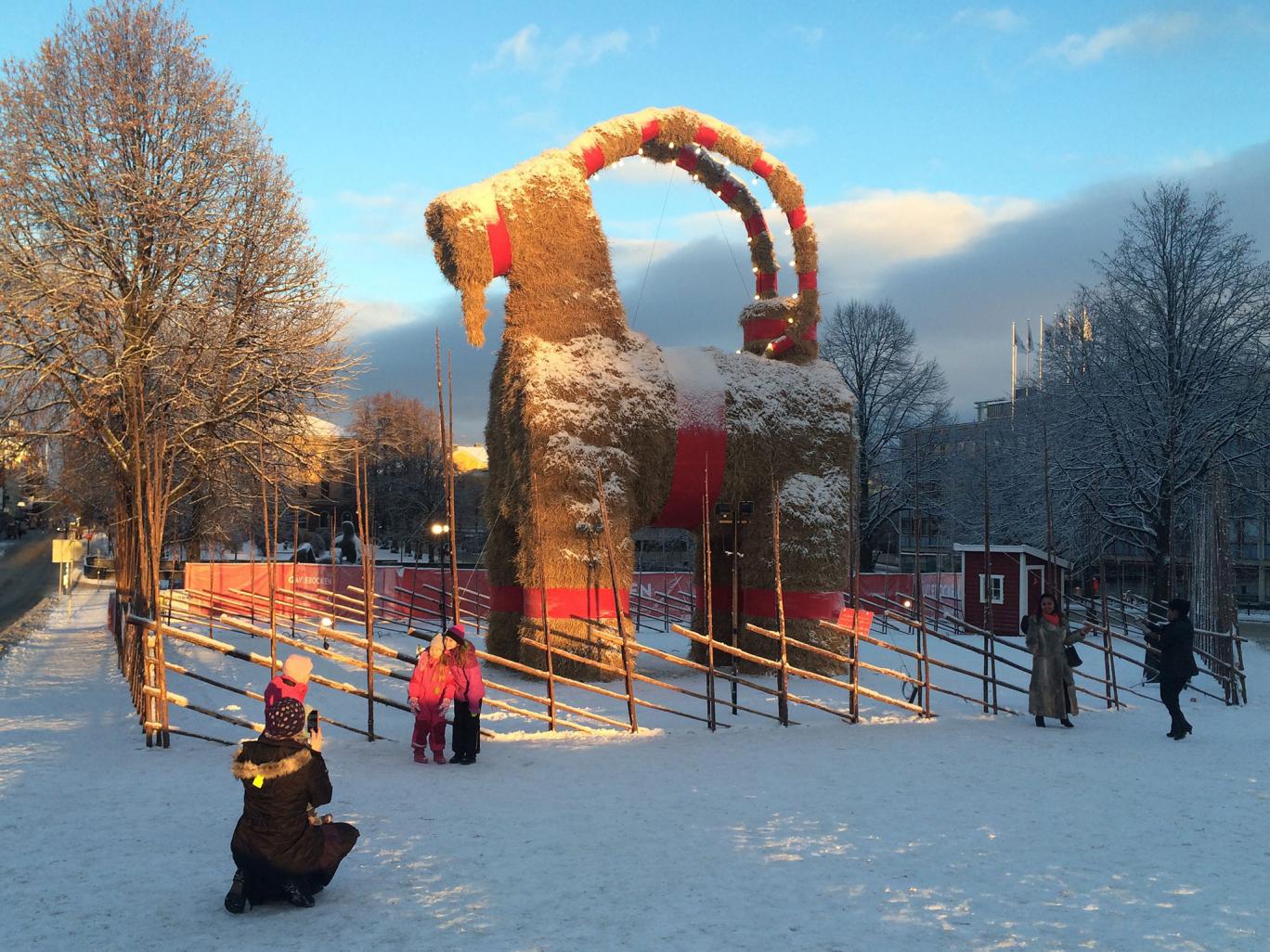The Rise and Fall of Mistletoe as a Christmas Tradition
Mistletoe is perhaps the most backwards of Christmas traditions.
Most today associate mistletoe with a Christmas kiss – something that happens now rarely, if spontaneously – and only if mistletoe is included in festive activities (it rarely is anymore).
Unlike most traditions of Christmas mistletoe has not really survived into modern times with the esteem and adaptability of other Christmas traditions.
Christmas trees, Christmas cards and Christmas carols have only become more popular with time. Mistletoe has not.
Trees, cards and carols have adapted to technology and changing tastes. Mistletoe has not.
In America, mistletoe was another tradition swiped of English Christmas practices and twisted into something a little different.
Over the course of the Victorian era mistletoe was a popular Christmas party pastime that was more unique to America than to England. It was as common as Christmas trees.
But in the first decade of the 20th century it stopped cold as a Christmas tradition.
Its failure to advance as other Christmas traditions have is evident in the fact that young people today cannot explain mistletoe beyond the Christmas kiss.
There is much more to the story of mistletoe.
~ The History of Mistletoe ~
Mistletoe might look festive in a modern way if only for its green color accented by creamy white berries. As an adornment it just works with the traditional colors and elements of Christmas decorating.

But anciently mistletoe was prized more for its symbolism than its look.
The word mistletoe loosely translates to “poop on a twig”, a reference to how it grows.
Tiny seeds of the mistletoe plant are ingested by birds, who over the course of their lives deposit those seeds in tree tops where birds live, and…do their business.
This high-in-the-air, soil-less planting of mistletoe seeds is a most unique biological arrangement.
Under “just right” environmental conditions the seeds take root within the branches of tall trees – usually the sturdy oak – and saps nutrients from the tree in order to thrive.
This parasitic arrangement can create a danger for the tree and inspire wonder at the same time.
Ancient Druid communities would venerate the mistletoe plant not only because it seemed to produce in the dead of winter but also overcame incredible odds just to survive.
The Druids would ceremoniously remove the mistletoe from the tops of trees with a gold knife and it was handled according to specific ceremonial rules.
It was for them a symbol of fertility. Because it was found on tree tops it was thought to have been planted by the gods.
In Norse tradition mistletoe was, in fact, an element of war and peace (love) for the gods.
Over time these pagan doctrines of mistletoe were tied to the traditions of Saturnalia.
As Christians came to power they adopted mistletoe much the same way they appropriated other pagan traditions of Christmas (such as the Yule log).
By the 1700s in England, mistletoe was a hold-over tradition from the raucous days of celebrating Christmas by the Lords of Mis-rule.
During those days of riotous Christmas celebration it was easy to adopt mistletoe and it’s kissing elements and fit it into the wife swapping and sex games so prevalent in the streets and the ancient churches.
The Christian churches did their best to clean it up.
Nowhere were the wild celebrations of Christmas justified in the Bible so they went to great lengths to normalize mistletoe as an element of worship.
For many years, especially in the Church of England, it was taught that mistletoe was the “forbidden tree” in the Garden of Eden and that it was banished from the Garden during the fall of Adam, causing it to depend upon other trees in order to survive.
As was common in the fractured environment of Europe’s Christian churches mistletoe was later banned as a decorative element of the season.
Its association with kissing was viewed as sinful.
Under the growing sensibilities of the late 18th and 19th century “rules” were adopted by those who continued to use mistletoe and the kissing games associated with it.
Older gentlemen would guide their wives or older ladies underneath the mistletoe and kiss them on the cheek, followed by the usual English curtsies.
For younger men and women the rules were similar but more complex.
Young men would kiss women on the lips and a kiss was allowed for each white berry on the bunch of mistletoe.
As kisses were bestowed berries would be plucked off the plant. Once the berries were gone all kissing stopped.
These formal rules of mistletoe naturally flowed to the United States and were modified over time. It morphed more into more of a young person’s party game and less of an older folk tradition in America.
In the early 19th century mistletoe as an English Christmas tradition was referenced in newspapers, magazines and literary works.

A poem about mistletoe from 1849
Dickens mentioned mistletoe but really it was a poem and a song that carried the repeated phrase “the mistletoe bough” that caught on as a trend in Christmas celebrations.
~ Ghost Stories and Kissing Games ~
Christmas celebrations during the early 19th century in America were kind of all over the place. In some areas of the country the custom centered on small family gatherings. In other areas it was not unusual to have gatherings of young people.
The Christmas parties followed the Victorian rules of social integrations. Men and women could meet at such occasions but only after a formal introduction or invitation.
The music, the dancing and the games all followed styles and rules.
Storytelling was a natural part of the celebrations and, thanks to Dickens especially, the telling of ghost stories was a popular Christmas pastime.
“The Mistletoe Bough” was a ghost story and it was wildly popular and traditional.
Naturally the telling of The Mistletoe Bough would give way to the placement of mistletoe on a fixture usually centered in the room.
Any young lady coming underneath this festive ornamentation was expected to allow a kiss to a man who caught her there.
As you can imagine, these events included a number of set ups and pre-planned placements.
In some circles, “luck” was associated with the game. If a young lady did not get a kiss under the mistletoe during these games it meant she would remain unwed in the year to come.
Likewise, a young woman who had one of the berries plucked for her participation could hold it as a token that she would be married soon.
 |
~ Mistletoe in the Media ~
Throughout the Victorian era and early into the 20th century Christmas mistletoe remained a festive and cheerful element of the season.
Each year newspapers and magazines would explain the origins of mistletoe and share stories and quips of it in practice at Christmas time.
Like Christmas cards and their affect on the national postal system the “mistletoe market” was tracked in the news. Some years it was plentiful, other years because of drought and other natural events, it was hard to find.
Mistletoe was so popular that newsboys would sell it the week before Christmas with their newspapers in large cities and others would use it to earn Christmas money by selling it door to door. It was also a very popular fund raiser item for charities.
Mistletoe in the United States flourished in the south.
In an odd reversal, it was one item of Christmas frequently imported from the south to the north. Most trees and traditional holly came from the north but mistletoe was almost exclusively a southern crop.
For many years, what mistletoe cost and how available it would be was tracked in the media and many Christmas seasons would simply not be complete without it.
~ The Downfall of Mistletoe ~
A series of events and circumstances combined during the first decade of the 20th century that snuffed out mistletoe as a common element of Christmas.
First, in some places, the kissing games got a little out of hand:
Said one newspaper after a Christmas party in 1900: “Husbands and brothers are incensed over promiscuous kissing which took place at a Christmas dance. Invitations went only to the best families, and a select little party danced Christmas Eve away. Near the entrance was a large bough of mistletoe, who put it there is the question now being asked by irate mankind. Beneath this bow many maidens paused, and it was here that lip met lip in full view of the assemblage.”
From New Jersey, of all places, clergymen claimed the practice of Christmas kissing games had to end.
“I am strongly opposed to certain Christmas entertainments, such as kissing parties, held by the younger element. They do not understand the importance or the spirit of their religion, or they would stay at home or go to church and read their prayer books…I am opposed to these gatherings, and warn you young people against that curse-parties. It is the beginning of a notorious ending.”
In addition, changing social norms created some new attitudes.
For men, it was a hesitancy to be so forward in public with a young lady. For women, it was the tepid nature of men that turned them off to the practice.
This cartoon kind of demonstrates that shift:

Some men also got carried away.
From 1905 in a Baltimore newspaper we read the story of a man suing his would-be bride for $25,000 in a breach-of-promise lawsuit.
A witness in the case declared the man “overworked the mistletoe” at a New Year’s party, which led to the couple’s breakup. In court the judge told the man “lots of men had been jilted before and advised him to forget it”.
But other men froze under the glaring pressure mistletoe could provide at a Christmas party.
From a story in the Kalamazoo Gazette in Michigan the tale is told of a man who hung mistletoe and then got “cold feet”:
“Mr. Whipple brough a piece of mistletoe into the office and suspended it from a gas light close to his desk…a pretty miss entered the office a few minutes after…and stood directly underneath it. Everyone in the office stopped to watch Mr. Whipple. He coughed slightly to attract the attention of the young woman. She looked at him. He straightened his tie, adjusted his collar…’Look what’s over you’, said Whipple. The miss looked up, saw the mistletoe, but didn’t budge. ‘Don’t you see what you’re under?” said Whipple, losing his nerve. ‘Taint far over here,’ said the young woman. Whipple turned red, stopped and started to retreat. His fellow clerks called him to be a man, but he hurried off behind the counter…After the visitor had departed Whipple peeped into the room to see if the way was clear and then hastily detached the mistletoe from the light.”
Besides the shift in social sensibilities politics also got in the way with mistletoe.
In 1908 a huge political debate ensued that they called then the “War on Mistletoe”. The problem in Texas was that mistletoe was killing off all the trees – literally.
In an effort to fix the issue legislation was passed to eradicate mistletoe from state agriculture through various regulations. Naturally the debate extended in extremes:
“The gentlemen who pleaded for the preservation of mistletoe on sentimental grounds are way behind the times. Young America needs no such adventurous aid to kissing. Now if some heartless guy were to start a crusade against cosy corners, canoes, vine clad-verandas…or a dozen other things that are adjunct to the production of stimulating smacks…the gent might have had a valid excuse for ripping up the air of the capitol with lurid protests…But mistletoe? Naw. Nobody in this day and time uses the mistletoe. Nobody needs it… a weed up on a chandelier is not worth a tinker’s whoop.”
The media supported such arguments in the first decade of 20th century.
A report from 1904 said “Mistletoe has had its day. The dealers say there is little or no demand for it…”
A lot of bad press added to the anti-mistletoe sentiment.
A terrible story out of Oklahoma told of five children who died on Christmas because they ingested mistletoe berries. Even though the cause of death was later found to be meningitis that struck the entire community, the damage to the reputation of mistletoe had been done. The story was repeated from coast to coast.
By the 1920s mistletoe was considered a relic of Christmas decorating.
A newspaper in Duluth, Minnesota went out on the street to randomly seek the opinions of young women they found. One said, “We don’t need a plant to kiss. We’re going to kiss anyway.”
By the late 1940s mistletoe was less of a tradition and more of a Christmas afterthought. Said one Chicago columnist, “Any 16 year old girl will tell you that mistletoe is more a part of her hair-do than a practical Christmas tradition…”
Mistletoe, having fallen out of practice as a game piece for crowds of Christmas celebrants, has become just another element of the season, akin to Christmas tree ornaments or red bows. It’s there – but hardly celebrated as it once was.







That was such an interesting read. Thanks, Jeff. I had no idea about the history of mistletoe. The “poop on a twig” and “a tinker’s whoop” gave me quite the chuckle!
Funny, the last time we used real mistletoe was at a church youth Christmas party. Had no idea we were such heathens. 🙂